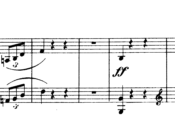Analysis
Contents
Prelude
SUMMARY:
This Prelude is founded upon the figure seen in Bar 1 above.
Bars 1-13: Period I. G sharp minor, it moves to the Relative major (Bar 4), touching F sharp minor and C sharp minor before returning to the Tonic minor. Transitions to end with a Perfect Cadence in the Dominant Minor, D sharp.
Bars 13-29: Period II. Starting from D sharp minor, with the Theme in the Bass part.
Bars 27-29: Coda. Using for foundation the theme in the Bass part, in Tonic key.
Bars 28,29: Plagal Cadence. Final Chord, Tierce de Picardie.
REMARKS:
The figure mostly employed for the material of this Prelude is seen in the Treble Bars 1, 2. It is used at the following important points as well as at other places, (1) at Bar 6 in the Relative Major (Bass part); (2) at Bar 13 in the Dominant Minor (Bass part); (3) at Bar 18 in the Subdominant Minor (Treble part); (4) at Bar 27 (Bass part), imitated in Contrary Motion by the Alto in Bar 28.
In both Preludes there are subdivsions. In Period I at Bar 5 (Cadence in Relative Major), and in Period II at Bar 18 (Cadence in the Subdominant Minor).
Fugue
ANALYSIS:
ENUNCIATION SECTION:
Bars 1-3: Subject in Tenor [G sharp minor].
Bars 3-5: Tonal Answer in Alto, with Counter-subject in Tenor [D sharp minor].
Bars 5-7: Subject in Treble. Counter-subject in Alto [G sharp minor].
Bars 7-9: Answer in Bass. Counter-subject in Treble [D sharp minor].
Bars 9-11: Episode I, modulating from G sharp minor to D sharp minor and Close.
Bars 11-13: Answer in Tenor. Counter-subject in Treble [D sharp minor].
Bars 13-15: Episode II, modulating from G sharp minor to C sharp minor and Close.
Bars 15-17: Real Answer in Bass. Counter-subject in Alto [G sharp minor].
Bars 17-19: Subject in Tenor. Counter-subject absent [G sharp minor].
Bars 19-21: Answer in Alto. Counter-subject in Tenor [D sharp minor].
MODULATORY SECTION
Bars 21-24: Episode III, modulating from G sharp minor to D sharp minor.
Bars 24-26: Subject in Treble. Counter-subject absent [D sharp minor].
Bars 26-28: Answer in Bass. Counter-subject absent [F sharp minor].
Bars 28-32: Episode IV, modulating from B to G sharp minor and Close.
RECAPITULATORY SECTION:
Bars 32-34: Subject in Tenor. Counter-subject in Alto [G sharp minor].
Bars 34-37: Episode V, modulating from D sharp minor to C sharp minor.
Bars 37-39: Answer in Treble. Counter-subject (reminiscence of) in Alto [D sharp minor].
Bars 39-41: Coda [G sharp minor].
SUMMARY:
Exposition: Bars 1-9.
Counter-exposition: Bars 11-17.
Episodes: Five.
Stretti: None.
Pedal: None.
Coda: Bars 39-41.
REMARKS:
- This Fugue has a “tonal” Answer and would be called a “tonal” Fugue. The alteration in the Answer, for the sake of tonality, is made from the first note to the second.
- In Bar 15 the Answer is exceptional, being Real instead of Tonal.
- The Counter-subject is absent on three occasions (see Analysis).
- The following is a brief description of the Episodes:
- Episode I is formed in the Bass from the second limb of the Subject in an ascending sequence. Plain harmonies only are used in the three upper parts.
- Episode II is formed in the Treble from the first limb of the Subject taken in contrary motion, the second limb being given to the Tenor, and suspensions to the Alto.
- Episode III is built mainly upon a new characteristic figure proposed bu the Bass and imitated in the fifths above by the Alto, the Tenor part being independent. The Treble rests.
- Episode IV is built upon precisely the same figure as Episode III, but placed in different voices – here Alto and Treble – the Bass part being independent. The Tenor rests.
- Episode V is formed mainly from the second limb of the Subject.








